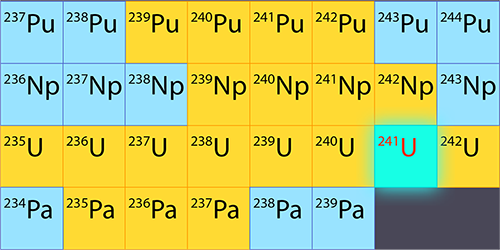Exploring the Borders of the Nuclear Landscape
The properties of heavy, neutron-rich isotopes are poorly known owing to difficulties in synthesizing these nuclei. Now Toshitaka Niwase at the High Energy Accelerator Research Organization (KEK) in Japan and his colleagues have helped to fill this knowledge gap. The researchers have directly determined the masses of 19 such isotopes, including a previously undetected uranium isotope: 241U [1]. These measurements will both test and refine existing nuclear models.
Niwase and his colleagues carried out their experiments at the KEK Isotope Separation System (KISS) facility in Saitama, Japan. They accelerated a beam of 238U nuclei into a rotating target of 198Pt nuclei. This process transferred multiple nucleons—protons and neutrons—between the beam and target nuclei, forming the isotopes of interest. The researchers then studied these isotopes using time-of-flight mass spectrometry, a method in which an ion’s mass is determined from the time it takes to travel a certain distance through a medium.
The team obtained precise mass values for 19 heavy isotopes that contain between 143 and 150 neutrons: 239Pu to 242Pu, 239Np to 242Np, 235U to 242U, and 235Pa to 237Pa. For most of these nuclei, these are the first direct mass measurements. The researchers say that their use of multinucleon transfer reactions combined with time-of-flight mass spectrometry provides a new way to probe the boundaries of the nuclear landscape. They also suggest that other combinations of beam and target nuclei could be used to synthesize and study nuclei possessing up to 154 neutrons.
–Ryan Wilkinson
Ryan Wilkinson is a Corresponding Editor for Physics Magazine based in Durham, UK.
References
- T. Niwase et al., “Discovery of new isotope 241U and systematic high-precision atomic mass measurements of neutron-rich Pa-Pu nuclei produced via multinucleon transfer reactions,” Phys. Rev. Lett. 130, 132502 (2023).




